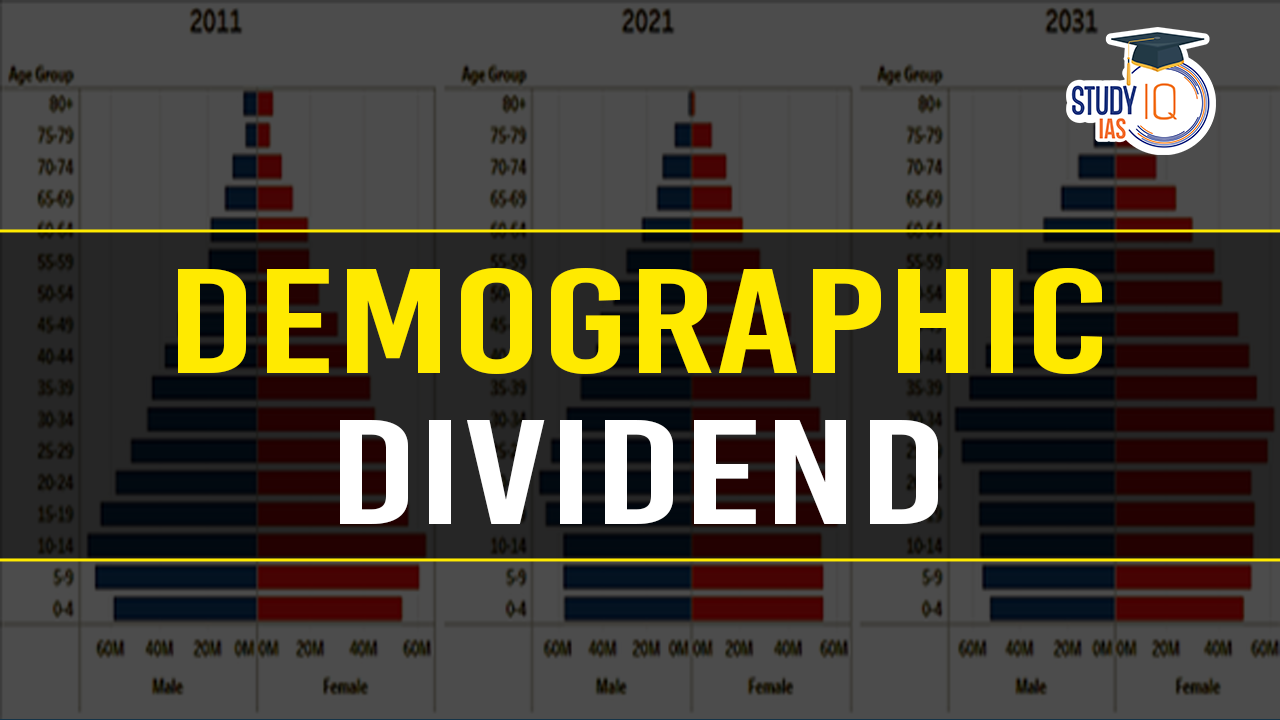A demographic dividend is a period when the working-age population is larger than the dependent population. The working-age population is usually between the ages of 15 and 64, while the dependent population is 14 years and younger or 65 years and older. Know all about Demographic Dividend in this article.
What is Demographic Dividend?
A demographic dividend is a country’s economic growth that occurs when the working-age population is larger than the non-working-age population. This happens when a country’s birth and death rates decline, resulting in a change in the population’s age structure. With fewer births each year, the number of young dependents decreases relative to the working-age population. This creates an opportunity for rapid economic growth if the country develops the right policies and investments.
The first demographic dividend period can last for five decades or more. The United Nations Population Fund (UNFPA) says that policies that can help realize a demographic dividend include:
- Improving access to quality education and jobs
- Investing in the health of young people, especially their sexual and reproductive health
India’s demographic dividend is expected to peak around 2041, when the working-age population is expected to reach 59%. It’s also expected to persist until at least 2055–56.
Demographic Dividend in India
- Demographic dividend refers to the economic growth potential resulting from shifts in a population’s age structure, particularly when the working-age population exceeds the dependent population.
- India’s demographic dividend is projected to peak around 2041, with the working-age population expected to reach 59%.
- This advantage provides an opportunity to invest in enhancing human capabilities, which can significantly impact societal and economic development.
Features of India’s Demographic Dividend
- Large Working-Age Population:
- India’s working-age population (15-64 years) surpassed the dependent population in 2018 and is expected to continue for 37 years until 2055.
- Uniqueness and Duration:
- India’s demographic dividend window spans five decades, longer than any other country, offering unique opportunities for growth.
- The timing of the demographic dividend varies across states due to population dynamics.
- Increasing Education Levels:
- Education levels are rising in India, with more individuals completing secondary and tertiary education, leading to a skilled workforce.
- Gender Equality:
- Progress in gender equality, including higher education levels and increased workforce participation among women, contributes to workforce productivity and size.
Importance of India’s Demographic Dividend
- Labour Supply:
- Increased labour supply as more individuals enter the workforce, driving economic growth.
- Capital Formation:
- Higher national savings rates due to a decrease in dependents, leading to increased capital formation through investment.
- Economic Growth:
- Demand-driven economic growth fueled by rising GDP per capita and decreasing dependency ratios.
- Innovation and Entrepreneurship:
- A young population fosters innovation and entrepreneurship, contributing to economic dynamism.
- Female Human Capital:
- Improved health and decreased fertility rates empower women to participate more in the workforce, enhancing human capital.
Challenges Associated with Harnessing the Demographic Dividend
- Lack of Job Creation:
- Insufficient job creation to absorb the growing workforce, leading to unemployment and underemployment.
- Quality Education and Skilling Gap:
- Education system inadequately prepares youth for the job market, resulting in a skills gap and unemployment.
- Poor Health and Nutrition:
- Health challenges, including malnutrition and inadequate healthcare access, hinder workforce productivity.
- Infrastructure Constraints:
- Inadequate infrastructure, particularly in rural areas, limits industrial growth and job creation.
- Social and Cultural Barriers:
- Patriarchal norms and gender inequalities restrict women’s workforce participation, limiting the demographic dividend.
- Environmental Issues:
- Rapid urbanization and industrial growth strain environmental resources, affecting sustainability.
Measures to Reap India’s Demographic Dividend
- Investment in Children and Adolescents:
- Increase spending on nutrition and early childhood learning to enhance human capital.
- Health Investments:
- Increase healthcare spending to ensure a healthy and productive workforce.
- Education Reforms:
- Reform education systems to align with industry needs and bridge the skills gap.
- Employment Creation Policies:
- Promote policies to create more jobs, particularly in small-scale industries and the informal sector.
- Female Workforce Participation:
- Implement policies to increase women’s participation in the workforce through skill development and empowerment initiatives.
- Favourable Business Environment:
- Create a conducive business environment with stable policies to attract investment and foster entrepreneurship.
- Investment in Emerging Technologies:
- Invest in research and development and support startups in emerging technologies to drive innovation and create high-skilled jobs.
- Address Regional Disparities:
- Address regional disparities in demographic transition by collaborating across states to optimize workforce potential.
- High-Level Task Force:
- Establish a high-level task force to oversee demographic dividend strategies and coordination across sectors.
Harnessing India’s demographic dividend requires strategic investments in education, healthcare, employment generation, and gender equality. By addressing challenges and implementing targeted policies, India can unlock the full potential of its young population and drive sustainable economic growth and development.
Sharing is caring!


 Sunrise Sectors in India, Key Characteri...
Sunrise Sectors in India, Key Characteri...
 Gold Price Surge in India, Key Drivers a...
Gold Price Surge in India, Key Drivers a...
 Fiscal Slippage, Causes and Implications
Fiscal Slippage, Causes and Implications





















